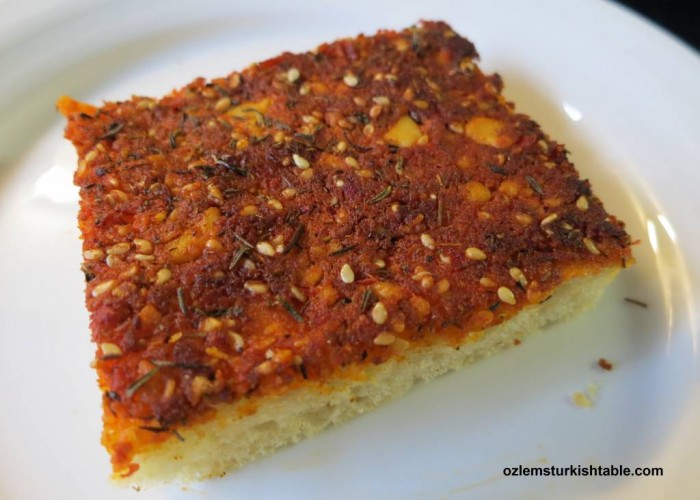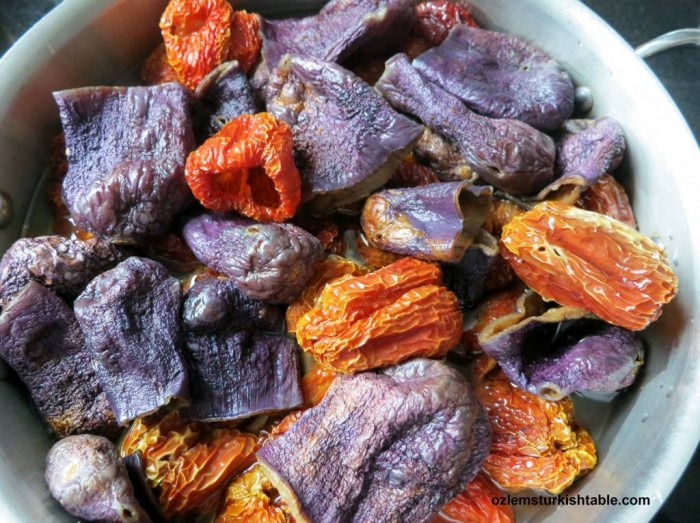This delicious flat bread with spicy red pepper paste, biber salcasi, feta cheese and za’atar or zahtar spice blend is a specialty from the Antakya cuisine and brings special memories back. I remember my grandmother and mum preparing the delicious topping at home and we children would take it to the local bakery, firin, to be baked over flat breads. They always smelled mesmerizing and we couldn’t wait to have a bite (or two).
Fresh Zahter or Zahtar is a popular herb grown in southern part of Turkey, especially around Kilis and Antakya in spring. Fresh zahter looks more like summer savory, or a crossing of marjoram, oregano and thyme. This herb is wonderful on salads like this Zeytin Ufeleme, Olive salad with pomegranate molasses and zahtar. Za’atar is also the name given to the exotic blend of herbs, spices and nuts, widely used in Southern Turkish as well as Middle Eastern cooking. At my home town, Antakya, zahtar blend is a rich mixture of dried zahter, sesame seeds, crushed cooked chickpeas, cumin, nigella seeds, sea salt, sumac and many more. It has a lovely, pungent, nutty taste and flavors salads, meat, and vegetables beautifully. In Antakya, locals simply dip their bread to a bowl of olive oil than to this zahtar blend for a delicious breakfast. I now see wholesome zahtar available even in supermarkets these days, you can also make your own zahter or za’atar blend, here’s my recipe.
These delicious and healthy flat breads also feature Antakya’s much loved olive oil, Turkish hot pepper paste, biber salcasi and crumbled feta cheese, cokelek. Combined with zahtar, sesame seeds and cumin, it makes a scrumptious, wholesome and fragrant topping for the flat breads. There is a delicious heat from red pepper paste, biber salcasi, a staple in Antakya cuisine and in my kitchen, which add so much flavor. You can make your own red pepper paste, biber salcasi with my recipe; it really is worth the effort. If not, you can add red pepper flakes, mixed with tomato paste instead.
I hope you enjoy Biberli Ekmek; it is delicious served as a mezze (try with hummus, muhammara, cevizli biber – red pepper paste and walnut dip or with cacik, yoghurt dip with cucumbers and dried mint), accompanies tea time, soups and main courses so well. My cookery book, Ozlem’s Turkish Table, Recipes from My Homeland, is a tribute to this rich culinary heritage and scrumptious authentic recipes like this delicious flat breads, dips, mezes, regional specialties are all included. You can get a signed copy at this link, if you’d like, now 25 % off for a limited time. We also have this new apron, featuring embroidery of Antakya’s daphne leaves in the design, it can make a lovely gift, you can order at this link.


Afiyet Olsun,
Ozlem
- For the dough:
- 3 cups/16 oz./ 1 lb. plain flour
- 1 sachet (7 gr ) dried yeast
- 5 ml/ 1 tsp salt
- ½ cup / 4 fl. oz. luke warm milk
- ¾ cup/ 5 fl. oz. luke warm water
- ⅓ cup / 3 fl. oz. olive oil
- For the topping:
- 200 gr/ 7 oz. crumbled feta cheese or cokelek
- 30 ml/ 2 tbsp. Turkish hot pepper paste, biber salcasi
- 15 ml / 1 tbsp. concentrated tomato paste
- 10 ml/ 2 tsp. ground cumin
- 45 ml/ 3 tbsp. sesame seeds
- 30 ml / 2 tbsp. zahtar or za’atar
- 30 ml/ 2 tbsp. olive oil
- Preheat the oven to 180 C / 350 F
- Prepare the topping first. Combine the crumbled feta (or cokelek), red pepper paste, tomato paste all the spices, sesame seeds and olive oil. Knead with your hands to blend them well to form a smooth paste. Set the topping aside.
- Now let’s make the dough. Combine the flour, dried yeast and salt in a large bowl.
- Stir in the warm milk, warm water and olive oil and knead for 3 minutes to form a soft dough. If it gets sticky, drizzle a little extra olive oil in your hand to shape the dough, it really helps.
- Grease a baking tray with 1 tbsp. olive oil and spread the dough as a thin flat bread base, reaching all the edges (about ¼ cm, 0.9”).
- Spread the topping evenly over the flat bread.
- Leave the flat bread with topping on at a warm spot to rise for 30 minutes.
- Once the dough's risen, bake in the preheated oven (180 C / 350 F) for 18 – 20 minutes.
- Let the baked flat bread with spicy feta cheese topping, Biberli Ekmek to cool down for 15 minutes.
- Slice and serve as part of a mezze spread or with tea, Turkish cay.

















